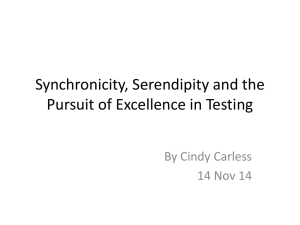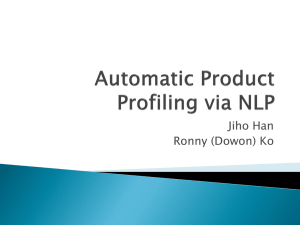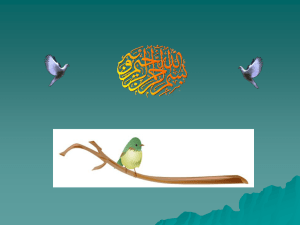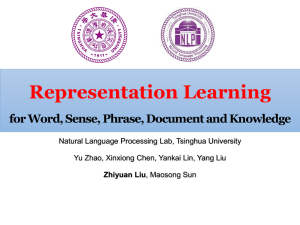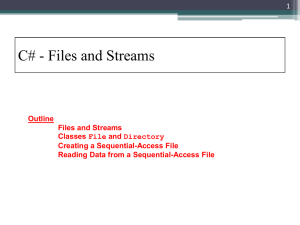read - NLP & IR Group @ UNED
advertisement
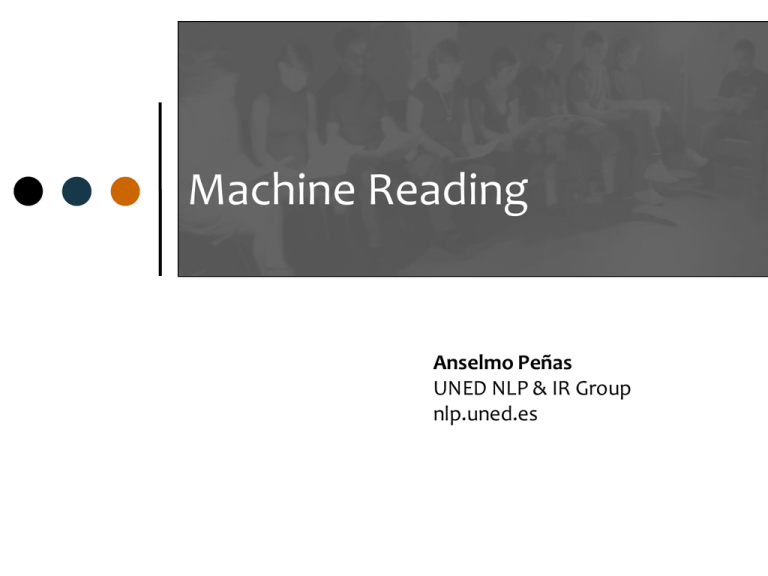
Machine Reading
Anselmo Peñas
UNED NLP & IR Group
nlp.uned.es
UNED
What’s this talk about?
Why are we so good understanding
language?
nlp.uned.es
UNED
What’s this talk about?
To know
Be aware of a specific piece of information
So you can use it
In particular, to understand language.
To understand language
Make sense of language (interpret)
So you convert it into a piece of information
that you are aware of.
nlp.uned.es
UNED
Knowledge - Understanding
dependence
We “understand” because we “know”
Capture ‘Background
Knowledge’ from text collections
‘Understand’ language
Reading cycle
nlp.uned.es
UNED
What’s this talk about?
How to test knowledge?
How to test knowledge acquired through
language?
Answering Questions
nlp.uned.es
UNED
Outline
1.
2.
3.
4.
5.
6.
Machine Reading
Limitations of supervised Information Extraction
From Micro-reading to Macro-reading: the semisupervised approach
Open Machine Reading: the unsupervised approach
Inference with Open Knowledge
Evaluation
nlp.uned.es
UNED
Reading Machine
Structured
Query
Text
Reading
Machine
Answer
Reasoning
Machine
A machine that produces
machine operable representations of texts
nlp.uned.es
UNED
Why a Reading Machine?
The majority of human knowledge is encoded in text
Much of this text is available in machine-readable
formats
Finding machine operable representations of texts
opens the door to the automatic manipulation of
vast amounts of knowledge
There is a big industry awaiting this event
nlp.uned.es
UNED
Why now?
1.
A change in the paradigms of Computational
Semantics
Conceptualizing content is not in the form of
symbols
but in the form of statistical distributions
2.
The power to capture the huge amount of
background knowledge
needed to read a single document
nlp.uned.es
UNED
Machine Reading Program
Phase II first attempt
Target
Ontology
Textual
Documents
Reading
Machine
Representation
according to the
Target Ontology
Questions and Answers are expressed
according to a Target Ontology
The Target Ontology changes with the
domain
Ideally, is an input to the MR system
Reasoning
Machine
Query
Answer
nlp.uned.es
UNED
Representation for reasoning
Player
Team
homeTeam
Event_Game
Event_Scoring
awayTeam
hasProperty
Measure
hasProperty
Target
Ontology
Event_Play
Event_Final_Scoring
loosingScore Score
winningScore
nlp.uned.es
UNED
Query in a Target Ontology
Query 20011: Who killed less than 35 people in Kashmir?
:- 'HumanAgent'(FileName, V_y),
killingHumanAgent(FileName, V_x, V_y),
'HumanAgentKillingAPerson'(FileName, V_x),
personGroupKilled(FileName, V_x, V_group),
'PersonGroup'(FileName, V_group),
'Count'(FileName, V_count),
value(FileName, V_count, 35),
numberOfMembersUpperBound(FileName, V_group, V_count),
eventLocationGPE(FileName, V_x, 'Kashmir').
nlp.uned.es
UNED
Representation gap
Target Ontology is oriented to express the QA
language
An extension is needed to enable reasoning:
Reasoning Ontology
Both are far from text
We need several levels of intermediate
representations
And mappings between them
nlp.uned.es
UNED
Mapping between representations
Textual
Documents
Reading
Representation
Reasoning
Representation
QA
Representation
Reading
Ontology
Reasoning
Ontology
Target
Ontology
Domain independent
Domain dependent
Domain
dependent
nlp.uned.es
UNED
Outline
1.
2.
3.
4.
5.
6.
Machine Reading
Limitations of supervised Information Extraction
From Micro-reading to Macro-reading: the semisupervised approach
Open Machine Reading: the unsupervised approach
Inference with Open Knowledge
Evaluation
nlp.uned.es
UNED
Reading Machine v.1
Information
Extraction
Textual
Documents
Categories
and
relations
used by the
IE engine
Supervised Learning
Reading
Representation
Reasoning
Representation
QA
Representation
Reading
Ontology
Reasoning
Ontology
Target
Ontology
nlp.uned.es
UNED
Supervised IE
Learn a direct mapping between the text
and the ontology
• Categories/classes, instances
• Relations
Need of many annotated examples
• For each category, relation
• For each domain
Speed up annotation
• Active Learning
nlp.uned.es
UNED
Not good enough
Conjunctive queries
Query performance is product of IE performance for each
entity and relation in the query
IE F1
Entities and relations in the query
0.9
'HumanAgent'(FileName, V_y),
0.8
killingHumanAgent(FileName, V_x, V_y),
0.9
'HumanAgentKillingAPerson'(FileName, V_x),
0.8
personGroupKilled(FileName, V_x, V_group),
0.9
'PersonGroup'(FileName, V_group), 'Count'(FileName, V_count),
value(FileName, V_count, 35),
numberOfMembersUpperBound(FileName, V_group, V_count),
0.9
eventLocationGPE(FileName, V_x, 'Kashmir').
0.42
Upper bound Performance
Will the Reasoning Machine recover from that?
nlp.uned.es
UNED
Local versus Global
Good performance in local decisions is not
enough
Texts are never 100% explicit
Relations are expressed in unlearned ways
You’ll miss some relations
Critical in conjunctive queries
nlp.uned.es
UNED
Local versus Global
We need global approaches
Joint models?
• E.g.: NER and Relation Extraction?
• Still inside a single document
Can we leverage redundancy in millions of
documents?
nlp.uned.es
UNED
Outline
1.
2.
3.
4.
5.
6.
Machine Reading
Limitations of supervised Information Extraction
From Micro-reading to Macro-reading: the semisupervised approach
Open Machine Reading: the unsupervised approach
Inference with Open Knowledge
Evaluation
nlp.uned.es
UNED
Local versus Global
What do we want?
Extract facts from a single given document?
•Micro-reading
Why a single doc?
•Depends on the final application scenario
Or do we want just extract facts?
•E.g. populate ontologies
Then, Can we leverage redundancy?
nlp.uned.es
UNED
Macro-reading
(Tom Mitchell)
Leverage redundancy on the web
“Target” reading to populate a given
ontology
Use coupled semi-supervised learning
algorithms
Seed learning using Freebase, DBpedia
nlp.uned.es
UNED
Semi-supervised Bootstrap
Bootstrapping
Start with few seeds
Find some patterns
Obtain new seeds
Find new patterns
…
Degenerates fast
nlp.uned.es
UNED
Semi-Supervised Bootstrap
Learning
Extract cities:
Seeds /
instances
patterns
Paris
Pittsburgh
Seattle
Cupertino
mayor of arg1
live in arg1
Example from Tom Mitchell
San Francisco
Austin
denial
anxiety
selfishness
Berlin
arg1 is home of
traits such as arg1
nlp.uned.es
UNED
Alternative 1: coupled learning
Coupled semi-supervised learning
Category/class and relation extractors
Cardinality of the relation
Compatible / mutual exclusive categories
Category subset / superset / orthogonal
…
nlp.uned.es
UNED
Alternative 1: coupled learning
Examples
Category and relation extractors
• John, lecturer at the Open University, …
One classifier
• Lecturer at -> employee_of
Three coupled classifiers
• John -> type_employee
• Open University -> type_company
• Lecturer at -> employee_of(type_employee, type_company)
nlp.uned.es
UNED
Alternative 1: coupled learning
Examples
Cardinality of the relation
• Cardinality(spouse(x,y,timestamp))={0,1}
If cardinality is 1
•Chose most probable as positive example
•Use the rest as negative examples
nlp.uned.es
UNED
Alternative 2: More seeds
Freebase
DBPedia
No bootstrap
Learn models instead of patterns
Use in combination with coupling
nlp.uned.es
UNED
Reading attached to the
ontology
Micro-reading take advantage of the
ontology
Known instances and their categories
Subset /superset relations
Typed relations
Macro-reading is beyond the sum of
micro-readings
•Coupling
nlp.uned.es
UNED
Drop the ontology?
But, What do we want?
Populate ontologies?
•Depends on the target application
Or increase the number of beliefs
available to our machine?
•Must those beliefs be targeted to an
ontology?
nlp.uned.es
UNED
Ontologies
Artificial
Predefined set of categories and
relations
•loosingTeam
•eventFinalScoring
Maybe too far from natural language
Impossible mapping without some
supervision
nlp.uned.es
UNED
Ontologies
Enable formal inference
•Specific-domain knowledge-based inferences
•Pre-specified with lots of human effort
•Machine assisted
Are they all the inferences we need?
•Not for the purposes of reading
nlp.uned.es
UNED
Outline
1.
2.
3.
4.
5.
6.
Machine Reading
Limitations of supervised Information Extraction
From Micro-reading to Macro-reading: the semisupervised approach
Open Machine Reading: the unsupervised approach
Inference with Open Knowledge
Evaluation
nlp.uned.es
UNED
So far…
From IE to Machine Reading
Corpus C
Background beliefs B
Yield a renewed set of beliefs B’
Reading(C) + B -> B’
Use B’ for inference in next reading cycle
nlp.uned.es
UNED
Drop the Ontology
So, What if there is no target ontology?
How to express / represent beliefs?
How to make inferences?
nlp.uned.es
UNED
Toward Open Machine Reading
Open Knowledge Extraction (Schubert)
•KNEXT
Open Information Extraction (Etzioni)
•TextRunner
Followers
•DART (P. Clark)
•BKB (A. Peñas)
•IBM PRISMATIC (J. Fan)
nlp.uned.es
UNED
Toward Open Machine Reading
How to represent beliefs?
We shouldn’t ignore what Reasoning
Machines are used to work with
nlp.uned.es
UNED
Representation
I can make
graphs!
I like
graphs
Do you like syntactic
dependencies?
Well…
Question
Reading
Machine
?
Answer
Reasoning
Machine
Text
Reasoning
Ontology
Target
Ontology
nlp.uned.es
UNED
Representation
Are typed syntactic dependencies a good starting
point?
Is it possible to develop a set of “semantic
dependencies”?
How far can we go with them?
Could we share them across languages?
What’s a semantic dependence? A probability
distribution?
Can we have a representation of the whole
document instead sentence by sentence?
nlp.uned.es
UNED
What else?
I have entities
and classes!
I like entities
and classes
What about person
/ organization /
location / other?
Question
Reading
Machine
?
Silly
machine…
Answer
Reasoning
Machine
Text
Reasoning
Ontology
Target
Ontology
nlp.uned.es
UNED
Classes
Easy ones
Not easy ones
Entity
• Named
•
•
•
•
Person
Organization
Location
Other
• Date
• Time
• Measure
•
•
•
•
The rest of words
(almost)
Skip all
philosophical
argue
Distance
Weight
Height
Other
•…
nlp.uned.es
UNED
Classes
Sure!
This is about US football
Can you
help me?
Great…
Reading
Machine
Question
?
Answer
Reasoning
Machine
Text
Maybe I should read
something about US football
Reasoning
Ontology
Target
Ontology
nlp.uned.es
UNED
Classes from text
Do texts point out classes? Of course
What classes? The relevant classes for reading
Uhm… this could be interesting…
Just small experiment:
Parse 30,000 docs. about US football
Look for these dependencies
NNP
NNP
nn
NN
NNP
appos
NN
be
NN
nlp.uned.es
UNED
Most frequent has-instance
334:has_instance:[quarterback:n, ('Kerry':'Collins'):name].
306:has_instance:[end:n, ('Michael':'Strahan'):name].
192:has_instance:[team:n, 'Giants':name].
178:has_instance:[owner:n, ('Jerry':'Jones'):name].
151:has_instance:[linebacker:n, ('Jessie':'Armstead'):name].
145:has_instance:[coach:n, ('Bill':'Parcells'):name].
139:has_instance:[receiver:n, ('Amani':'Toomer'):name].
…
nlp.uned.es
UNED
Most frequent classes
15457 quarterback
12395 coach
7865 end
7611 receiver
6794 linebacker
4348 team
4153 coordinator
4127 player
4000 president
3862 safety
3722 cornerback
3479 (wide:receiver)
3344 (defensive:end)
3265 director
3252 owner
2870 (tight:end)
2780 agent
2291 guard
2258 pick
2177 manager
2138 (head:coach)
2082 rookie
2039 back
1985 (defensive:coordinator)
1882 lineman
1836 (offensive:coordinator)
1832 tackle
1799 center
1776 (general:manager)
1425 fullback
1366 (vice:president)
1196 backup
1193 game
1140 choice
1102 starter
1100 spokesman
1083 (free:agent)
1006 champion
990 man
989 son
987 tailback
…
nlp.uned.es
UNED
Classes from text
Find more ways to point out a class in text?
Now you have thousands of seeds
Bootstrap!
But remember, coupled
nlp.uned.es
UNED
Classes
I have these
classes!
What a mess! Flat, redundant…! Where
are gameWinner, safetyPartialCount, …?
What?
Question
Reading
Machine
?
Answer
Reasoning
Machine
Text
Reasoning
Ontology
Target
Ontology
nlp.uned.es
UNED
Relations
gameWinner a
class!? Come on!
Ok, let’s move on… Show
me the relations you have
Relations?
Question
Reading
Machine
?
Answer
Reasoning
Machine
Text
Reasoning
Ontology
Target
Ontology
nlp.uned.es
UNED
Relations
Tom, ehm… What’s a relation?
Well… certainly, a relation is a n-tuple…
... n-tuple…
Like verb structures?
Uhm… this could be interesting…
Just small experiment:
Take the 30,000 docs. about US football and look for:
VB
VB
arg0
arg1
NN
NN
arg0
NN
arg1
NN
prep
NN
nlp.uned.es
UNED
Extraction of propositions
Patterns over dependency trees
prop( Type, Form : DependencyConstrains : NodeConstrains ).
Examples:
prop(nv, [N,V] : [V:N:nsubj, not(V:_:'dobj')] : [verb(V)]).
prop(nvnpn, [N1,V,N2,P,N3]:[V:N2:'dobj', V:N3:Prep, subj(V,N1)]:[prep(Prep,P)]).
prop(has_value, [N,Val]:[N:Val:_]:[nn(N), cd(Val), not(lemma(Val,'one'))]).
nlp.uned.es
UNED
Most frequent propositions
nvn:[person:n, do:v, thing:n]:1530.
nvn:[group:n, do:v, thing:n]:1264.
nvn:[group:n, win:v, game:n]:960.
nvn:[person:n, tell:v, person:n]:902.
nvn:[person:n, catch:v, pass:n]:814.
nvn:[group:n, have:v, chance:n]:656.
nvn:[person:n, miss:v, game:n]:580.
nvn:[person:n, throw:v, pass:n]:567.
nvn:[group:n, have:v, lot:n]:551.
nvn:[person:n, do:v, job:n]:490.
nvn:[group:n, lose:v, game:n]:482.
nvn:[person:n, have:v, problem:n]:479.
nvn:[person:n, tell:v, group:n]:473.
nvn:[person:n, throw:v, interception:n]:465.
nvn:[group:n, play:v, game:n]:464.
Considering pronouns
Person <- he, she
Thing <- it
Group <- we, they, us
nlp.uned.es
UNED
Most frequent propositions
nvn:[team:n, win:v, game:n]:297.
nvn:[team:n, have:v, record:n]:212.
nvn:[team:n, lose:v, game:n]:166.
Ignoring pronouns
nvn:[touchdown:n, give:v, lead:n]:160.
nvn:[team:n, play:v, game:n]:154.
nvn:[goal:n, give:v, lead:n]:154.
nvn:[ (field:goal):n, give:v, lead:n]:150.
nvn:[team:n, make:v, playoff:n]:146.
nvn:[team:n, win:v, championship:n]:136.
nvn:[touchdown:n, give:v, ((0: - : 0):lead):n]:135.
nvn:[goal:n, give:v, ((0: - : 0):lead):n]:124.
nvn:[ (field:goal):n, give:v, ((0: - : 0):lead):n]:123.
nvn:[offense:n, score:v, touchdown:n]:118.
nlp.uned.es
UNED
Most frequent “relations”
A relation is a n-tuple between instances of
certain type
I was playing with NNPs as instances…
Let’s generalize and aggregate:
Marino -> NAME
Bulger -> NAME
Jones -> NAME
…
nlp.uned.es
UNED
Most frequent “relations”
nvn:['NAME', beat:v, 'NAME']:3884.
nvn:['NAME', catch:v, pass:n]:2567.
nvn:['NAME', play:v, 'NAME']:2382.
nvn:['NAME', lead:v, 'NAME']:2285.
nvn:['NAME', score:v, touchdown:n]:2261.
nvn:['NAME', throw:v, pass:n]:2107.
nvn:['NAME', win:v, game:n]:2010.
nvn:['NAME', replace:v, 'NAME']:1971.
nvn:['NAME', say:v, 'NAME']:1945.
nvn:['NAME', have:v, 'NAME']:1866.
nvn:['NAME', win:v, 'NAME']:1747.
nvn:['NAME', sign:v, 'NAME']:1740.
nvn:['NAME', defeat:v, 'NAME']:1663.
nvn:['NAME', hit:v, 'NAME']:1446.
nvn:['NAME', kick:v, goal:n]:1433.
Now
I know instance classes
I know propositions
involving instances
Let’s find the probability
of the classes given a
proposition
nlp.uned.es
UNED
Most probable typed relations
nvn:['NAME', throw:v, pass:n]:[quarterback]:0.00116408907425231.
nvn:['NAME', catch:v, pass:n]:[receiver]:0.000947483419496505.
nvn:['NAME', throw:v, (touchdown:pass):n]:[quarterback]:0.000767205964030132.
nvn:['NAME', throw:v, interception:n]:[quarterback]:0.000415367155661766.
nvn:['NAME', catch:v, pass:n]:[(wide:receiver)]:0.000406047565796885.
nvn:['NAME', say:v, linebacker:n]:[linebacker]:0.000395901727835594.
nvn:['NAME', rank:v, (no:'.'):n]:[(no:'.')]:0.000392502869262291.
nvn:['NAME', rank:v, (0:no:'.'):n]:[(no:'.')]:0.000392502869262291.
nvn:['NAME', complete:v, pass:n]:[quarterback]:0.000390269288924688.
nvn:['NAME', catch:v, (0:pass):n]:[receiver]:0.000346249735543358.
nvn:['NAME', catch:v, pass:n]:[end]:0.00033397730214679.
nvn:['NAME', throw:v, ((0: - : yard):pass):n]:[quarterback]:0.000304392988179183.
nvn:['NAME', have:v, sack:n]:[end]:0.000297055408474171.
nvn:['NAME', intercept:v, pass:n]:[safety]:0.000292011905223431.
nlp.uned.es
UNED
Relations between classes
Now I can ask about the relations between classes
Quarterback & receiver
nvn:['NAME', hit:v, 'NAME']:[quarterback, receiver]:3.67432997918756e-06.
nvn:['NAME', find:v, 'NAME']:[quarterback, receiver]:1.8192935712796e-06.
nvnpn:['NAME', complete:v, pass:n, to:in, 'NAME']:[quarterback, receiver]:1.4512783860507e-06.
nvnpn:['NAME', throw:v, pass:n, to:in, 'NAME']:[quarterback, receiver]:1.37642726590848e-06.
nvnpn:['NAME', catch:v, pass:n, from:in, 'NAME']:[receiver, quarterback]:1.16492444555009e-06.
nvnpn:['NAME', throw:v, (touchdown:pass):n, to:in, 'NAME']:[quarterback, receiver]:1.0606850217847e-06.
If there is only one relevant relation between them, they are
paraphrases
nlp.uned.es
UNED
Relations between classes
But you can have many relevant relations between same classes
Team and game
nvn:['NAME', win:v, game:n]:[team]:9.69097313067351e-05.
nvn:['NAME', lose:v, game:n]:[team]:5.96928038789563e-05.
nvn:['NAME', play:v, game:n]:[team]:2.7232092783388e-05.
nvn:['NAME', have:v, game:n]:[team]:2.5404025345459e-05.
nvn:['NAME', enter:v, game:n]:[team]:1.32010748425686e-05.
nvn:['NAME', (not:win):v, game:n]:[team]:5.77931930517973e-06.
nvn:['NAME', forfeit:v, game:n]:[team]:5.30734251201793e-06.
nvn:['NAME', tie:v, game:n]:[team]:3.95409472849798e-06.
nvn:['NAME', reach:v, game:n]:[team]:3.66152627590672e-06.
nvn:['NAME', average:v, game:n]:[team]:3.45676070239657e-06.
nvnpn:['NAME', extend:v, streak:n, to:in, game:n]:[team]:3.29470336174047e-06.
How to cluster different realizations of the same relation?
[Research question]
nlp.uned.es
UNED
Inferring entity classes
Now, when I see something (named) doing things, I can guess its
class
Culpepper directed a 15-play drive
nvn:['NAME', direct:v, drive:n]:[quarterback]:3.37813951038364e-05.
nvn:['NAME', direct:v, drive:n]:[backup]:2.98954603541518e-06.
nvn:['NAME', direct:v, drive:n]:[man]:1.56144396948542e-06.
nvn:['NAME', direct:v, drive:n]:[freshman]:1.48171220798502e-06.
nvn:['NAME', direct:v, drive:n]:[passer]:1.3913157132247e-06.
And when I see it doing many things in a document, I can
aggregate the evidence on its class. How?
[Research question]
nlp.uned.es
UNED
Propositions into axioms
“Can we axiomatize this?”, asked Jerry
Why not?
P(quarterback, throw, pass)=0.0011
P(quarterback | throw, pass) = p
throw(x,y), pass(y) -> quarterback(x) | p
nlp.uned.es
UNED
Relations between events
“Can you find the ways to express causality?”,
asked Rutu
Why not? Give me a seed
Touchdown & victory
NVN 14 'touchdown':'give':'victory'
NVN 11 'touchdown':'seal':'victory'
NVN 4 'touchdown':'secure':'victory‘
nlp.uned.es
UNED
Relations between events
Give
NVN 136 'touchdown':'give':'lead'
NVN 130 'goal':'give':'lead'
NVN 85 'pass':'give':'lead'
Seal
NVN 12 'interception':'seal':'victory'
NVN 11 'touchdown':'seal':'victory'
NVN 6 'pass':'seal':'victory‘
Secure
NVN 5 'victory':'secure':'title'
NVN 4 'group':'secure':'title'
NVN 4 'victory':'secure':'championship'
nlp.uned.es
UNED
Relations between events
Set_up
NVN 25 'interception':'set_up':'touchdown'
NVN 20 'pass':'set_up':'touchdown'
NVN 19 'interception':'set_up':'goal'
NVN 14 'pass':'set_up':'goal'
NVN 14 'return':'set_up':'touchdown'
NVN 12 'interception':'set_up':'score'
NVN 11 'fumble':'set_up':'touchdown'
NVN 11 'run':'set_up':'touchdown'
NVN 10 'person':'set_up':'touchdown'
NVN 9 'return':'set_up':'goal'
NVN 9 'pass':'set_up':'run'
NVN 9 'interception':'set_up':'run'
NVN 9 'run':'set_up':'goal'
nlp.uned.es
UNED
IE approach
Reading Machine?
IE
Textual
Documents
Entities and
relations
used by the
IE engine
Reading
Representation
Reading
Ontology
nlp.uned.es
UNED
A Reading Machine more like this
Aggregation and
generalization
Textual
Documents
Reading
Reading
Cycle
Background
Knowledge
Inference
nlp.uned.es
UNED
Bridging the gap
What if we want a target ontology?
Reasoning with representations closer to
the text
Representations of text closer to the
Reasoning Ontology
nlp.uned.es
UNED
The Reading Machine
Aggregation and
generalization
Textual
Documents
Reading
Reading
Cycle
Enrichment
Background
Knowledge
Mapping
Question
Reasoning
Machine
Answer
Seeding
Linking
Target
Ontology
Reasoning
Ontology
nlp.uned.es
UNED
The Reading Machine
Iterate over big amounts of text
1.
2.
Process texts up to reified logic forms
Generalization and aggregation of frequent
structures in the logic forms
1.
2.
3.
4.
Estimation of their probability distributions
Dumping intermediate Background Knowledge Bases
(BKB)
Enrichment of initial text representations (BKBs
are then used to fill the knowledge gaps)
Repeat with the enriched representation of texts
nlp.uned.es
UNED
Outline
1.
2.
3.
4.
5.
6.
Machine Reading
Limitations of supervised Information Extraction
From Micro-reading to Macro-reading: the semisupervised approach
Open Machine Reading: the unsupervised approach
Inference with Open Knowledge
Evaluation
nlp.uned.es
UNED
Inference with Open Knowledge
Open Machine Reading
How to make inferences?
What inferences?
This connects with
Textual Entailment and Paraphrasing
Question Answering (not structured)
…
nlp.uned.es
UNED
Enrichment
Why is so difficult to reason about a single text?
Because almost all the knowledge you need to
interpret the text is outside the text, assumed as
reader’s background knowledge
We need to add the missing information: Enrichment
the process of adding explicitly to a text’s
representation the information that is either
implicit or missing in the text
nlp.uned.es
UNED
Text omits information
San Francisco's Eric Davis intercepted a Steve Walsh pass on
the next series to set up a seven-yard Young touchdown
pass to Brent Jones.
nlp.uned.es
UNED
Make explicit implicit information
San Francisco's Eric Davis intercepted a Steve Walsh pass on the next series to
set up a seven-yard Young touchdown pass to Brent Jones.
Implicit
(More) explicit
San Francisco’s Eric Davis Eric Davis plays for San Francisco
E.D. is a player, S.F. is a team
Eric Davis intercepted pass1 Steve Walsh pass1 Steve Walsh threw pass1
Steve Walsh threw interception1…
Young touchdown pass2 Young completed pass2 for touchdown…
touchdown pass2 to Brent Jones Brent Jones caught pass2 for touchdown
nlp.uned.es
UNED
Make explicit implicit information
Automatic recovering of such omitted
information
nlp.uned.es
UNED
Background Knowledge Base
(NFL, US football)
?> NPN 'pass':X:'touchdown‘
NPN 712 'pass':'for':'touchdown'
NPN 24 'pass':'include':'touchdown’
…
?> NVN 'quarterback':X:'pass'
NVN 98 'quarterback':'throw':'pass'
NVN 27 'quarterback':'complete':'pass‘
…
?> NVNPN 'NNP':X:'pass':Y:'touchdown'
NVNPN 189 'NNP':'catch':'pass':'for':'touchdown'
NVNPN 26 'NNP':'complete':'pass':'for':'touchdown‘
…
?> NN NNP:’pass’
NN 24 'Marino’:'pass‘
NN 17 'Kelly':'pass'
NN 15 'Elway’:'pass’
…
?> NVN 'end':X:'pass‘
NVN 28 'end':'catch':'pass'
NVN 6 'end':'drop':'pass‘
…
?>X:has-instance:’Marino’
20 'quarterback':has-instance:'Marino'
6 'passer':has-instance:'Marino'
4 'leader':has-instance:'Marino'
3 'veteran':has-instance:'Marino'
2 'player':has-instance:'Marino'
nlp.uned.es
UNED
Enrichment example (1)
…to set up a 7-yard Young touchdown pass to Brent Jones
Young
touchdown
nn
nn
Jones
to
pass
Young pass
?> X:has-instance:Young
X=quarterback
?> NVN:quarterback:X:pass
X=throw
X=complete
pass to Jones
?> X:has-instance:Jones
X=end
?> NVN:end:X:pass
X=catch
X=drop
nlp.uned.es
UNED
Enrichment example (2)
…to set up a 7-yard Young touchdown pass to Brent Jones
Young
throw
complete
touchdown
nn
Jones
catch
drop
pass
touchdown pass
?> NVN touchdown:X:pass
False
?> NPN pass:X:touchdown
X=for
nlp.uned.es
UNED
Enrichment example (3)
…to set up a 7-yard Young touchdown pass to Brent Jones
Young
throw
complete
touchdown
for
Jones
catch
drop
pass
?> NVNPN NAME:X:pass:for:touchdown
X=complete
X=catch
nlp.uned.es
UNED
Enrichment example (4)
…to set up a 7-yard Young touchdown pass to Brent Jones
Young
complete
touchdown
for
Jones
catch
pass
Young complete pass for touchdown
Jones catch pass for touchdown
nlp.uned.es
UNED
Enrichment
Build context for instances
Build context for dependencies
Finding implicit predicates
Constrain interpretations
nlp.uned.es
UNED
Enrichment example (5)
San Francisco's Eric Davis
intercepted a Steve Walsh
pass on the next series to
set up a seven-yard Young
touchdown pass to Brent
Jones.
Before enrichment
After enrichment
throw
catch
complete
for
nlp.uned.es
UNED
What BKBs need for enrichment? (1)
Ability to answer about instances
•Not complete population
•But allow analogy
Ability to constrain interpretations and
accumulate evidence
•Several different queries over the same
elements considering different structures
•Require normalization (besides parsing)
nlp.uned.es
UNED
What BKBs need for enrichment? (1)
Ability to discover entity classes with
appropriate granularity level
•Quarterbacks throw passes
•Ends catch passes
•Tag an entity as person or even player is not
specific enough for enrichment
Text frequently introduces the relevant class
(appropriate granularity level) for understanding
nlp.uned.es
UNED
What BKBs need for enrichment? (2)
Ability to digest enough knowledge adapted to
the domain
•Crucial
Approaches
•Open IE (web scale) + domain adaptation
• Shallow NLP, lack of normalization
•Reading in context (suggested here)
• Consider only documents in the same context
• Deeper NLP
nlp.uned.es
UNED
Digest enough knowledge
DART: general domain Proposition Store
TextRunner: general domain Open IE (web-scale)
BKB: Proposition Store in context
(e.g. only 30,000 docs about American Football)
?> quarterback:X:pass
DART
(no results)
TextRunner
(~200) threw
(~100) completed
(36) to throw
(26) has thrown
(19) makes
(19) has
(18) fires
BKB (US Football)
(99) throw
(25) complete
(7) have
(5) attempt
(5) not-throw
(4) toss
(3) release
nlp.uned.es
UNED
Digest Knowledge in the same context
(entity classes)
?> X:intercept:pass
DART
(13) person
(6) person/place/organization
(2) full-back
(1) place
TextRunner
(30) Early
(26) Two plays
(24) fumble
(20) game
(20) ball
(17) Defensively
BKB (US Football)
(75) person
(14) cornerback
(11) defense
(8) safety
(7) group
(5) linebacker
nlp.uned.es
UNED
Digest Knowledge in the same context
(ambiguity problem)
?> person:X:pass
DART
TextRunner
BKB (US Football)
(47) make
(45) take
(36) complete
(30) throw
(25) let
(23) catch
(1) make
(1) expect
(22) gets
(17) makes
(10) has
(10) receives
(7) who has
(7) must have
(6) acting on
(6) to catch
(6) who buys
(5) bought
(5) admits
(5) gives
(824) catch
(546) throw
(256) complete
(136) have
(59) intercept
(56) drop
(39) not-catch
(37) not-throw
(36) snare
(27) toss
(23) pick off
(20) run
nlp.uned.es
UNED
Different contexts, different
expectations
?> person:X:pass
NFL Context
905:nvn:[person:n, catch:v, pass:n].
667:nvn:[person:n, throw:v, pass:n].
286:nvn:[person:n, complete:v, pass:n].
204:nvnpn:[person:n, catch:v, pass:n, for:in, yard:n].
85:nvnpn:[person:n, catch:v, pass:n, for:in, touchdown:n].
IC Context
6:nvn:[person:n, have:v, pass:n]
3:nvn:[person:n, see:v, pass:n]
1:nvnpn:[person:n, wear:v, pass:n, around:in, neck:n]
BIO Context
<No results>
nlp.uned.es
UNED
Different contexts, different
expectations
?> X:receive:Y
NFL Context
55:nvn:[person:n, receive:v, call:n].
34:nvn:[person:n, receive:v, offer:n].
33:nvn:[person:n, receive:v, bonus:n].
29:nvn:[team:class, receive:v, pick:n].
IC Context
78 nvn:[person:n, receive:v, call:n]
44 nvn:[person:n, receive:v, letter:n]
35 nvn:[group:n, receive:v, information:n]
31 nvn:[person:n, receive:v, training:n]
BIO Context
24 nvn:[patients:n, receive:v, treatment:n]
14 nvn:[patients:n, receive:v, therapy:n]
13 nvn:[patients:n, receive:v, care:n]
nlp.uned.es
UNED
Conclusions
A context can be built on demand
“Retrieve 30,000 relevant docs. for the one under
reading”, destille background knowledge
Limiting to a specific context provides some powerful
benefits
Ambiguity is reduced
Higher density of relevant propositions
Different distribution of propositions across domains
Amount of source text is reduced, allowing deeper
processing such as parsing
Specific tools for specific domains
nlp.uned.es
UNED
Outline
1.
2.
3.
4.
5.
6.
Machine Reading
Limitations of supervised Information Extraction
From Micro-reading to Macro-reading: the semisupervised approach
Open Machine Reading: the unsupervised approach
Inference with Open Knowledge
Evaluation
nlp.uned.es
UNED
Evaluation
The evaluation of these machines is an
open research question
It is also an opportunity to consolidate
the community around the field
nlp.uned.es
QA4MRE, Question Answering
for Machine Reading Evaluation
Organization
Anselmo Peñas (UNED, Spain)
Eduard Hovy (USC-ISI, USA)
Pamela Forner (CELCT, Italy)
Álvaro Rodrigo (UNED, Spain)
Richard Sutcliffe (U. Limerick, Ireland)
Roser Morante (U. Antwerp, Belgium)
Walter Daelemans (U. Antwerp, Belgium)
Corina Forascu (UAIC, Romania)
Caroline Sporleder (U. Saarland, Germany)
Yassine Benajiba (Philips, USA)
Advisory Board 2011 (TBC 2012)
Ken Barker, (U. Texas at Austin, USA)
Johan Bos, (Rijksuniv. Groningen, Netherlands)
Peter Clark, (Vulcan Inc., USA)
Ido Dagan, (U. Bar-Ilan, Israel)
Bernardo Magnini, (FBK, Italy)
Dan Moldovan, (U. Texas at Dallas, USA)
Emanuele Pianta, (FBK and CELCT, Italy)
John Prager, (IBM, USA)
Dan Tufis, (RACAI, Romania)
Hoa Trang Dang, (NIST, USA)
UNED
Question Answering Track at CLEF
2003
2004
2005
2006
2007 2008
Multiple Language QA Main Task
QA
Tasks
Temporal
restrictions
and lists
2009
2010
ResPubliQA
Answer Validation
Exercise (AVE)
Giki
CLEF
Real
Time
QA over Speech
Transcriptions (QAST)
WiQA
WSD
QA
2011
2012
QA4MRE
Negation and Modality
Biomedical
nlp.uned.es
UNED
New setting: QA4MRE
QA over a single document:
Multiple Choice Reading Comprehension Tests
• Forget about the IR step (for a while)
• Focus on answering questions about a single text
• Chose the correct answer
Why this new setting?
nlp.uned.es
UNED
Systems performance
Upper bound of 60% accuracy
Overall
Best result
<60%
Definitions
Best result
>80%
NOT
IR approach
nlp.uned.es
UNED
Pipeline Upper Bound
Question
Question
analysis
Passage
Retrieval
0.8
Answer
Extraction
x
0.8
Answer
Answer
Ranking
x
1.0
=
0.64
Not enough evidence
SOMETHING to break the pipeline: answer
validation instead of re-ranking
nlp.uned.es
UNED
Multi-stream upper bound
Best with
ORGANIZATION
Perfect
combination
81%
Best system
52,5%
Best with
PERSON
Best with
TIME
nlp.uned.es
UNED
Multi-stream architectures
Different systems response better different
types of questions
•Specialization
•Collaboration
Question
QA sys1
SOMETHING for
combining /
selecting
QA sys2
QA sys3
QA sysn
Answer
Candidate
answers
nlp.uned.es
UNED
AVE 2006-2008
Answer Validation: decide whether to return the
candidate answer or not
Answer Validation should help to improve QA
Introduce more content analysis
Use Machine Learning techniques
Able to break pipelines and combine streams
nlp.uned.es
UNED
Hypothesis generation + validation
Answer
Searching space
of candidate
answers
Hypothesis
generation
functions
+
Answer
validation
functions
Question
nlp.uned.es
UNED
ResPubliQA 2009 - 2010
Transfer AVE results to QA main task 2009 and 2010
Promote QA systems with better answer validation
QA evaluation setting assuming that
To leave a question unanswered has more value
than to give a wrong answer
nlp.uned.es
UNED
Evaluation measure
(Peñas and Rodrigo, ACL 2011)
Reward systems that maintain accuracy but
reduce the number of incorrect answers by
leaving some questions unanswered
nR
1
c @ 1 (nR nU
)
n
n
n: Number of questions
nR: Number of correctly answered questions
nU: Number of unanswered questions
nlp.uned.es
UNED
Conclusions of ResPubliQA 2009 – 2010
This was not enough
We expected a bigger change in systems
architecture
Validation is still in the pipeline
IR -> QA
No qualitative improvement in performance
Need of space to develop the technology
nlp.uned.es
UNED
2011 campaign
Promote a bigger change in QA systems
architecture
QA4MRE: Question Answering for Machine
Reading Evaluation
Measure progress in two reading abilities
Answer questions about a single text
Capture knowledge from text collections
nlp.uned.es
UNED
Reading test
Text
Coal seam gas drilling in Australia's
Surat Basin has been halted by
flooding.
Australia's Easternwell, being
acquired by Transfield Services, has
ceased drilling because of the
flooding.
The company is drilling coal seam
gas wells for Australia's Santos Ltd.
Multiple choice test
According to the text…
What company owns wells in Surat
Basin?
a) Australia
b) Coal seam gas wells
c) Easternwell
d) Transfield Services
e) Santos Ltd.
f) Ausam Energy Corporation
g) Queensland
h) Chinchilla
Santos said the impact was minimal.
nlp.uned.es
UNED
Knowledge gaps
Australia
drill
I
Company A
II
Well C
for
Queensland
Company B
own | P=0.8
is part of
is part of
Surat Basin
Texts always omit information
We need to fill the gaps
Acquire background knowledge from the reference
collection
nlp.uned.es
UNED
Multilingual axioms?
Can we learn these axioms from previous reading
of many texts?
company(A,x), drill(e1,x,y), well(C,y), for(e,z), company(B,z) ->
own(e2,z,y)
An axiom learned in one language,
Can be used to fill gaps in another language?
Why not?
How? What do we need?
nlp.uned.es
UNED
Evaluation setting requirements
Don’t fix the representation formalism
Don't build systems tuned for specific domains
But general technologies, able to self-adapt to new
contexts or topics
Evaluate reading abilities
Semantic representation beyond sentence level is part
of the research agenda
Knowledge acquisition
Answer questions about a single document
Control the role of knowledge
nlp.uned.es
UNED
Control the variable of knowledge
The ability of making inferences about texts is
correlated to the amount of knowledge considered
This variable has to be taken into account during
evaluation
Otherwise it is very difficult to compare methods
How to control the variable of knowledge in a reading
task?
nlp.uned.es
UNED
Sources of knowledge
Text Collection
Big and diverse enough to acquire required knowledge
• Impossible for all possible topics
Define a scalable strategy: topic by topic
Several topics
Narrow enough to limit knowledge needed (e.g.
Petroleum industry, European Football League,
Disarmament of the Irish Republican Army, etc.)
Reference collection per topic (10,000-50,000 docs.)
• Documents defining concepts about the topic (e.g. wikipedia)
• News about the topic
• Web pages, blogs, opinions
nlp.uned.es
UNED
Evaluation tests (2011)
12 reading tests (4 docs per topic)
120 questions (10 questions per test)
600 choices (5 options per question)
Translated into 5 languages:
English, German, Spanish, Italian, Romanian
Plus Arabic in 2012
Questions are more difficult and realistic
100% reusable test sets
nlp.uned.es
UNED
Evaluation tests (2011)
44 questions required background knowledge from the
reference collection
38 required combine info from different paragraphs
Textual inferences
Lexical: acronyms, synonyms, hypernyms…
Syntactic: nominalizations, paraphrasing…
Discourse: correference, ellipsis…
nlp.uned.es
UNED
Evaluation
QA perspective evaluation
c@1 over all 120 questions
Reading perspective evaluation
Aggregating results test by test
Task
Registered
groups
Participant
groups
Submitted Runs
QA4MRE 2011
25
12
62 runs
nlp.uned.es
UNED
QA4MRE 2012 Main Task
Topics
new
1.
2.
3.
4.
AIDS
Music and Society
Climate Change
Alzheimer (divulgative sources: blogs, web,
news, …)
Languages
new
1. English, German, Spanish, Italian, Romanian
2. Arabic
nlp.uned.es
UNED
QA4MRE 2012 Pilots
Modality and Negation
Given an event in the text decide whether it is
1.
2.
3.
Asserted (no negation and no speculation)
Negated (negation and no speculation)
Speculated
Roadmap
1.
2.
2012 as a separated pilot
2013 integrate modality and negation in the main task
tests
nlp.uned.es
UNED
QA4MRE 2012 Pilots
Biomedical domain
Same setting than main but
Scientific language (require domain adaptation)
Focus on one disease: Alzheimer (~50,000 docs)
Give participants the background collection already
processed: Tok, Lem, POS, NER, Dependency
parsing
Development set
nlp.uned.es
UNED
QA4MRE 2012 in summary
Main task
Multiple Choice Reading Comprehension tests
Topics: AIDS, Music and Society, Climate Change,
Alzheimer
English, German, Spanish, Italian, Romanian, Arabic
Two pilots
Modality and negation
• Asserted, negated, speculated
Biomedical domain focus on Alzheimer disease
• Same format as the main task
nlp.uned.es
UNED
Schedule
Guidelines and Samples of tests
1st February
Release of topics and reference corpora 1st April
Test set release
1st June
Run submissions
15th June
Results to the participants
1st July
Submission of Notebook Papers
August - September
Web site: http://celct.fbk.eu/QA4MRE/
nlp.uned.es
UNED
Conclusion
Augment the local process with global,
statistical inferences that leverage redundancy
and coupling
You can target to an ontology: Macro-reading
Or explore the unsupervised
Integrate this idea in your tools and applications
-> research
Don’t forget to evaluate: QA4MRE
nlp.uned.es
Thanks!
121
